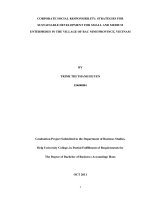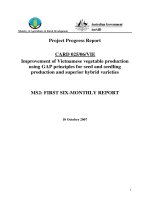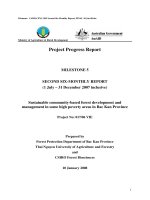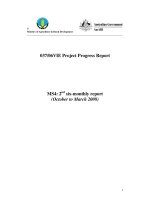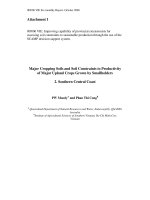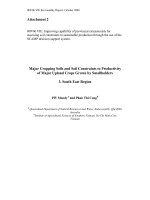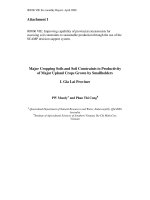Dự án nông nghiệp " Developing a strategy for enhancing the competitiveness of rural small and medium enterprises in the agro-food chain: the case of animal feed (Milestone 7) " potx
Bạn đang xem bản rút gọn của tài liệu. Xem và tải ngay bản đầy đủ của tài liệu tại đây (245.94 KB, 12 trang )
1
Ministry of Agriculture & Rural Development
Project Progress Report
Milestone 7: THIRD SIX-MONTHLY REPORT
CARD Project 030/06 VIE
Developing a strategy for enhancing the competitiveness of rural
small and medium enterprises in the agro-food chain: the case of
animal feed
Date: 30
th
May 2009
1
Table of Contents
1. Institute Information ___________________________________________________ 2
2. Project Abstract _________________________________________________________ 3
3. Executive Summary ____________________________________________________ 3
4. Introduction & Background _____________________________________________ 4
5. Progress to Date _______________________________________________________ 5
5.1 Implementation Highlights ________________________________________________ 5
5.2 Smallholder Benefits______________________________________________________ 8
5.3 Capacity Building ________________________________________________________ 8
5.4 Publicity________________________________________________________________ 9
5.5 Project Management _____________________________________________________ 9
6. Report on Cross-Cutting Issues__________________________________________ 10
6.1 Environment ___________________________________________________________ 10
6.2 Gender and Social Issues _________________________________________________ 10
7. Implementation & Sustainability Issues ___________________________________ 10
7.1 Issues and Constraints ___________________________________________________ 10
7.2 Options________________________________________________________________ 10
7.3 Sustainability___________________________________________________________ 10
8. Next Critical Steps ____________________________________________________ 11
9. Conclusion __________________________________________________________ 11
2
1. Institute Information
Project Name
Developing a strategy for enhancing the
competitiveness of rural small and medium
enterprises in the agro-food chain: the case of animal
feed
Vietnamese Institution
Institute of Policy and Strategy for Agriculture and
Rural Development
Vietnamese Project Team Leader
Dr Nguyen Do Anh Tuan
Australian Organisation
University of Western Australia
Australian Personnel
Ms Sally Marsh, Dr Donna Brennan, Professor John
Pluske, Dr Greg Hertzler (left UWA in Jan 2008), Dr
Jo Pluske
Date commenced
1
st
May 2007
Completion date (original)
30
th
April 2009
Completion date (revised)
30th September 2009
Reporting period
1
st
May 2008 – 31
st
October 2008
Contact Officer(s)
In Australia: Team Leader
Name:
Ms Sally Marsh
Telephone:
+61 8 6488 4634
Position:
Research Assistant
Professor
Fax:
+61 8 6488 1098
Organisation
University of Western
Australia
Email:
In Australia: Administrative contact
Name:
Ms Jan Taylor
Telephone:
+61 8 6488 1757
Position:
School Manager
Fax:
+61 8 6488 1098
Organisation
Agricultural and Resource
Economics, University of
Western Australia
Email:
In Vietnam
Name:
Ms. Pham Thi Lien Phuong
Telephone:
+84-4-37868232
Position:
Researcher – Market Analysis Unit
Fax:
+84-4-37280489
Organisation
Center for Agricultural Policy –
Institute of Policy and Strategy for
Agriculture and Rural Development
(CAP-IPSARD)
Email:
3
2. Project Abstract
3. Executive Summary
Work during this six-month period (May – October 2008) has largely focussed on the
implementation of the survey of livestock feed enterprises in north and south
Vietnam, and undertaking the study tour to Thailand.
The questionnaire for feedmills took longer than anticipated to complete, but was pre-
tested and finalised by the end of April 2008. The survey was then implemented in
southern Vietnam during May 2008 (in Tien Giang and Long An provinces in the
Mekong River Delta, and Binh Duong and Dong Nai provinces in the South-East
region), and northern Vietnam during June 2008 (in Ha Noi, Ha Tay and Hung Yen
provinces in the Red River Delta). Dr Brennan accompanied the CAP team to south
Vietnam to oversee the commencement of surveying.
The study tour to Thailand took place from June 9-13, 2008. The delegation included
a policy maker representative (from the Department of Livestock production), a
representative from a technical research institute (Agriculture Research Institute for
Southern Vietnam), a representative from a SME in the animal feed sector and the
research team members from CAP/IPSARD and UWA. The delegation met with the
Thai Department of Livestock Development, the FAO Regional Livestock Office, the
Thai Feed Mill Association, and visited both small and larger field mills and a dairy
farm.
Training activities during this period have focussed on practical hands-on quantitative
work, supervised by Dr Brennan and Ms Marsh, associated with data cleaning and
survey data analysis, following the completion of the feedmill survey.
A report on the key issues and the completed survey for feedmills was submitted and
accepted as Milestone 4 (Data collection strategy) in May 2008. Milestones 5 (Second
six monthly report) and 6 (Study tour report) were prepared during this six months
and submitted in December 2008.
The objectives of this project are to: 1) Build capacity at IPSARD in agricultural marketing
research, specifically the value chain, industrial organization and production economics; 2)
Understand the role and performance of SMEs in the animal feed sector in other countries and
draw lessons for Vietnam; 3) Provide a quantitative assessment of the factors affecting the
competitiveness of the animal feed industry in Vietnam; and 4) Provide policy recommendations
to the government with regard to the efficiency of firms operating in the livestock feed sector, and
provide advice to SMEs competing in the livestock feed sector. Standard agricultural economics
techniques will be used to quantify the characteristics of the animal feed industry, and to identify
issues and opportunities for small enterprises in the animal feed supply chain. Activities include a
combination of training courses, and supervised research exercises combining collection of
secondary data, field work, analysis and synthesis of findings. Activities during the third six
months of the project have focussed on: 1)implementation of the feedmill survey in north and
south Vietnam (May and June 2008); 2) data entry for the completed feedmill questionnaires and
commencement of data cleaning and analysis; 3) undertaking the study tour to Thailand (June
2008) and writing the study tour report; 4) preparation of the survey instrument for livestock
p
roducers.
4
Work is now progressing steadily in several areas including:
• analysis of the feedmill survey data, and writing a report of the descriptive
statistics from the survey data (first draft finished in January 2009);
• development of further survey questions specific for livestock producers (this
survey was undertaken in November and December 2008);
• data entry, cleaning and preliminary analysis of the survey data from livestock
producers;
• completing compilation and analysis of available secondary data;
• documentation of activities for the training manual; and
• planning for future training activities for 2 CAP staff at UWA associated with
the analysis of the survey data.
4. Introduction & Background
The underlying aim of this project is to investigate the circumstances under which
SMEs in Vietnam can operate at an efficient level and compete with other firms or
not, especially in the context of the globalization process. This project seeks to gain
benefit from Australian collaboration in designing methodology that can be used in
ongoing work at IPSARD. In this study the animal feed industry is being used as a
case study, but the methods and lessons learned will be applicable in other areas of
agricultural marketing. The proposed training and supervised research exercises will
provide the IPSARD/MARD with a suitable methodology for ongoing work in
quantitative policy analysis.
The project will be carried out using a combination of training courses, and
supervised research exercises combining collection of secondary data, field work,
analysis and synthesis of findings in reports and policy briefs. Training will focus on
building skills and experience in market analysis, including value chain analysis,
production economics, and industrial organisation. Field work will be undertaken in
several sites incorporating the three regions, Mekong Delta, South East region and
Red River Delta, to cover a broad cross section of performance of animal feed
enterprises. Local stakeholders will be involved throughout the process, and findings
communicated through a workshop held in each region.
Specific activities and outputs under the project objectives will include:
Objective 1: Build capacity at IPSARD agricultural marketing research, specifically in
analysis of the value chain, industrial organisation, and production economics
• Training workshops at IPSARD on survey and data collection techniques; and
market analysis, including value chain analysis, production economics, and
industrial organisation.
• On-the-job training for IPSARD staff on assessment of competitiveness of SMEs
and other firms in the Vietnamese animal feed value chain.
• Development of a manual on how to conduct a study of competitiveness of SMEs
that can be used in other studies to be implemented by IPSARD in the future.
Objective 2: Understand the role and performance of SMEs in the animal feed sector
in other countries
5
• Desk-top literature search and review of the nature, experiences and lessons of the
animal feed industries in other countries, and the role of SMEs in the animal feed
sector globally.
• A study tour to Thailand to assess the organization of the livestock feed sector,
and its applicability to Vietnam.
Objective 3: Provide a quantitative assessment of the factors affecting the
competitiveness of the animal feed industry in Vietnam
• Collection of secondary data to provide an up-to-date assessment of the animal
feed industry in Vietnam, and, opportunities and challenges facing the sector.
• Field investigation in three regions to examine the value chain of the animal feed
industry including an assessment of characteristics and costs of production, the
nature of information and product flow, quality control standards and processes.
• Compilation of a detailed report on the research work.
Objective 4: Provide policy recommendations to the government with regard to the
efficiency of firms operating in the livestock feed sector, and provide advice to SMEs
in the sector.
• Writing of policy briefs.
• Workshops in study regions and in Hanoi, to report and discuss the findings of the
research work with local stakeholders and with policy makers.
5. Progress to Date
5.1 Implementation Highlights
Implementation of the survey of livestock feedmills:
The main aim of this feed mill survey is to provide a quantitative assessment of the
factors affecting the competitiveness of the animal feed industry in Vietnam. The
following objectives were addressed in the survey:
• To obtain data on mill characteristics and production costs, output and prices
by types of ownership, regions and size of mills.
• To obtain data on the nature of information and product flow, quality control
standards and processes for livestock feed mills.
Feed mills in seven provinces across the country were selected to take part in the
survey, which took place between May and June 2008. The field work was undertaken
in three ecological regions; in provinces which were the biggest producers of
livestock feed, to cover a broad cross-section of animal feed enterprises. Feedmills
were surveyed in Ha Noi, Ha Tay and Hung Yen provinces located in the Red River
Delta; Binh Duong and Dong Nai in the South East; and Tien Giang and Long An in
the Mekong River Delta. The three regions had previously been identified in the
project proposal while six out of the seven provinces were agreed upon by the project
team and CARD. Hung Yen province was added because of a lack of sufficient
enterprises in Ha Noi, resulting from recent changes in this province compared to
2006 data (on which the original selection of provinces was made).
A stratified size classification criteria of mills was specified with mills divided into 5
classes based on output capacity (tonnes/year): (1) <5,000; (2): >=5,000 and <10,000;
6
(3): >=10,000 and < 20,000; (4): >=20,000 and <80,000; and (5): >=80,000. The
number of mills of each size required to be sampled in each province was calculated
so that they were in proportion to the actual number and size distribution of mills
located in the six survey provinces and the total needed number (70 mills). In the end
it was not possible to reach the desired sample size of 70 mills. Many mills on the list
provided by the Department of Livestock Production had gone out of business and
could not be replaced with other mills of the same size in the province. The final
sample distribution from the seven provinces is shown in Table 1.
Table 1: Total sample size by province and region
Province
Region
No. of surveyed enterprises Percent of sample
Ha Noi
Red River Delta
9 14.5
Ha Tay
Red River Delta
6 9.7
Hung Yen
Red River Delta
12 19.4
Binh Duong
South East
19 30.7
Dong Nai
South East
9 14.6
Long An
Mekong River Delta
4 6.4
Tien Giang
Mekong River Delta
3 4.4
Total
62 100
Before each survey, secondary data and information were collected to get an overall
background of livestock production and feed use in a particular province. During the
survey, our experienced enumerators worked under the close supervision of the
project team. However, the information provided was sometimes not consistent
between different sections of the questionnaire because of issues regarding the
confidentiality of some types of data (e.g. production costs). Data checking and
cleaning were done very carefully to ensure that matching sections of data were
consistent (e.g. raw material inputs and production outputs). In particular, the
production data was inconsistent for many firms, as seen by its relationship with other
relevant data on input use, revenue and profit. Therefore, although the total sample
surveyed is 62 mills, only data from 44 mills were accepted for analysis in terms of
production output (i.e. mill classification by size).
Table 2 shows the total sample size by ownership and then the production size of the
surveyed enterprises which were able to be classified, and hence the percentage of
enterprises in each ownership category who provided consistent production data.
From the table, around 70% of the total sample can be accepted for production
analysis while the rest is omitted. Particularly, nearly half of those companies in the
registered private foreign group were omitted due to their very problematic data.
Table 2: Sample size by ownership status and by scale classification
Total
sample By scale classification
Share of
total sample
By ownership status
Smallest Medium Largest Total
State owned company 3 1 1 1 3 100%
Equitised 14 6 4 2 12 86%
7
Registered private
foreign 13 1 4 2 7 54%
Joint venture 4 0 2 1 3 75%
Registered private
national 28 9 9 1 19 68%
Total 62 17 20 7 44 71%
In the report all the analyses by region and ownership status will be done with the
total sample of 62, but only 44 mills will be used when analysis is based on the scale
classification. The data cleaning process was finished during this reporting period and
the analysis of the data and report on the descriptive statistics of the survey data and
the livestock feed sector in Vietnam are now well underway.
Study tour to Thailand:
The study tour to Thailand took place from June 9-13, 2008. The delegation included
a policy maker representative (from the Department of Livestock production), a
representative from a technical research institute (Agriculture Research Institute for
Southern Vietnam), a representative from a SME in the animal feed sector and the
research team members from CAP/IPSARD and UWA. The list of delegates is
attached as Appendix I. Mr.Teerasant Sirichayaporn, Executive chairman of the Thai
Feed Mills Public Company Limited and Mr. Pornsil Patchrintanakul, President of
Thai Feed Mill Association played host for the trip.
The study tour aimed to help the project team and some key sector stakeholders gain a
better understanding of:
• livestock feed production in Thailand;
• participation of SMEs in the livestock feed sector in Thailand; and
• the role of public policy in the livestock feed sector in Thailand.
The delegation met with the Thai Department of Livestock Development, the FAO
Regional Livestock Office, the Thai Feed Mill Association, and visited both small and
larger field mills and a dairy farm. A copy of the study tour schedule is attached as
Appendix II.
Following the visit, all study tour participants contributed to a Study Tour Report, and
the CAP team took responsibility for the coordination of this document. The Study
Tour Report was submitted to the CARD office in December 2008. The following
conclusions of lessons applicable to Vietnam’s livestock feed were made in the
Report.
• Lessons applicable to livestock feed policy makers
o For both export-oriented and domestic market oriented firms, the Thai DLD is
responsible for testing in the DLD lab system, and all the tests required by the
DLD are free-of-charge. Enterprises are required to keep regular records of
their testing results, and this is a good way of monitoring feed quality as well
as helping enterprises to get used to the GMP and HACCP procedures. The
DLD provides free training courses on GMP and HACCP, which encourages
mills to have accredited GMP and HACCP.
8
o The Thai government considers feedmills as an agricultural business, and as
such pays no VAT. This is also the situation in China. This policy encourages
the production and reduces the price of animal feed.
o The Thai government controls the price of animal feed.
• Lessons applicable to SMEs
o SMEs in Thailand appear to have a attitude toward challenges and external
shocks that is reflected in their positive marketing approach. Instead of waiting
for support from government or elsewhere, they focus on how to sell above the
breakeven point.
o SMEs in Thailand try to source feed ingredients locally, as much as possible,
and look for the cheapest good quality ingredient with the cost as low as
possible. This needs to be considered in the case of Vietnam because Vietnam
has capacity to produce raw materials for livestock feed.
o SMEs can always find a “niche market”, being “niche producers”, using
“niche raw materials”: in other words, there are always markets for low and
high quality feeds. SMEs can compete on price and after sale-services for
farmers.
o Some SMEs have a cooperative structure. The form of Mualek cooperative,
which supplies multiple services to members (e.g. feed, fuel, marketing of
product) is a good example for the Vietnam feed industry.
• Possible role for the Vietnam Feed Association
o The Thailand Feed Association plays an active policy role. A change in
structure of the VFA would be needed if it were to play a similar role to the
TFA. The Vietnam government has a policy to encourage an active role for the
private sector, so it may be useful to consider supporting and promoting a
more pro-active policy role for the VFA in the future.
5.2 Smallholder Benefits
At this stage of the project no smallholder benefits have been achieved, but this
remains an objective of the project, through increased efficiency and competitiveness
in the livestock feed sector.
5.3 Capacity Building
Capacity building activities at IPSARD/CAP have continued, and during this period
were focussed on practical hands-on work, supervised by Dr Brennan and Ms Marsh,
associated with data entry, data cleaning and data analysis, following the completion
of the feedmill survey.
Dr Brennan conducted a 3-day training course in Microsoft Access (data entry
program) in late July/ early August following a direct request from CAP staff. This
course aimed to build skills in designing data entry templates in Access, a task that
CAP has often needed to outsource. CAP junior staff directly involved with the feed
9
mill survey (Bui Hai Nguyen, Pham Thi Lien Phuong, Nguyen Thi Thinh) attended
the course, and practice work was based on the feed mill surveys already collected.
Other senior and junior researchers working in the Market Analysis Division and
Rural Development Division of CAP also attended the training: Do Huy Thiep,
Nguyen Anh Phong, Nguyen Le Hoa, Nguyen Que Nga, Nguyen Nghia Lan, Truong
Thu Trang, Trang Tien Cong and Nguyen Hong Thanh. In total, around 11 people
attended the course, and at the completion of the training CAP staff were capable of
designing effective data entry templates using Access. To reinforce the skills learnt, it
was planned that the CAP staff should design the data entry templates for the
producer survey questionnaires.
Training in September focussed on .data cleaning, with Dr Brennan conducting
several half-day and full-day sessions with CAP staff to build skills in data cleaning
using STATA. In October, Dr Brennan and Ms Marsh designed templates for the CAP
team to provide guidance and direction for the preliminary analysis of the data. Dr
Brennan and Ms Marsh then provided feedback on the extracted data provided by the
CAP team (in Excel worksheets) before the CAP team started work on the report of
the livestock feed enterprises.
5.4 Publicity
There were no specific publicity activities during this reporting period.
5.5 Project Management
We are still experiencing difficulties in keeping up with the timing of Milestone
Reports, but the work load associated with the project during this six month period
and the period after has been heavy, particularly for the CAP team.
Dr Donna Brennan has taken maternity leave from January to May 2009 inclusive.
This will mean a delay in the project completion, as her input is essential for the
completion of Milestones 8 and 9. Because of the late start up to the project, Ms
Marsh has an existing contract with UWA to employ her on the CARD project (at
20%) through to end September 2009. We propose that the project completion date
now be 30 September 2009, with Milestones 8, 9 and 10 submitted in
August/September 2009 or as completed.
Options for in-kind assistance from the School of Agricultural and Resource
Economics (SARE), following the departure of Dr Greg Hertzler, have proved
difficult to identify. Both Dr Brennan and Ms Marsh have been providing more than
their budgeted time input to the project, which has assisted with the provision of the
technical assistance and training that is required. It is hoped that arrangements will be
able to be made for training of CAP staff at SARE as planned during July/August
2009. This training will focus on advanced analysis of the data, and finalisation of the
report on the livestock feed sector.
10
6. Report on Cross-Cutting Issues
6.1 Environment
Questions addressing environmental issues and concerns were included in the survey
instrument, and will be addressed in the report of the livestock feed enterprises.
6.2 Gender and Social Issues
Questions addressing gender and social issues and concerns (e.g. females working in
livestock and livestock feed businesses, health and safety issues in the sector) were
included in the survey instrument. Quality control in the livestock feed sector (food
safety) was identified as a key issue to investigate on the study tour to Thailand, and
the delegation found that the Thai Department of Livestock Development puts
considerable emphasis on food safety and quality control in the livestock feed sector.
7. Implementation & Sustainability Issues
7.1 Issues and Constraints
The late start to the project, and staffing issues with the Australian team is putting
pressure on the completion time of the project. Specifically, as Dr Brennan has taken
maternity leave from January – May 2009 inclusive, we would like to request an
extension for project completion and submission of Milestones 8, 9 and 10 from 31
st
April 2009 to 30
th
September 2009. This will enable Dr Brennan to have input into
these final Milestone activities. We are not requesting any additional funding.
Recent global developments in the sector, including sharp increases in the costs of
energy and livestock feed raw materials, have the potential to bias the data from the
survey of sector participants as well as put pressure on SMEs in the sector in general.
The project team is aware of the pressure on the livestock feed sector, and will
endeavour to assess the data in the light of these developments.
7.2 Options
The location of Dr Donna Brennan within CAP in Hanoi since October 2007 has
meant that it is possible to deliver shorter training sessions with key CAP people. This
approach is useful because it fits more easily within the busy work schedule of CAP
team members, and has proved useful during the data cleaning and analysis stages.
7.3 Sustainability
The location of Dr Brennan in CAP has contributed to the sustainability of the skills
and knowledge being applied by the project team in this project, by enabling more
frequent follow-up and feedback on activities. Under the guidance of Dr Brennan and
Ms Marsh, analysis of the data and writing of the reports (in English) is being
undertaken by the CAP team to ensure that they are “learning-by-doing”.
11
8. Next Critical Steps
Activities for the next six months include:
• Completion of the survey development for livestock producers, piloting,
implementation of the survey with livestock producers in the designated
survey provinces, encoding of data, and commencement of data analysis.
• Further analysis and completion of the report on feedmills in Vietnam.
• Planning and conducting training activities associated with the analysis of the
survey data, including planning for appropriate training in Australia for two
members of the CAP project team.
• Continue work on documenting training activities and compiling the content
of the training manual.
• Towards the end of the project: writing of the policy briefs, and planning for
the stakeholder workshops.
9. Conclusion
Much of the work undertaken during this reporting period was associated with the
implementation of the survey of livestock feed mills in south and north Vietnam.
These were completed successfully and data encoding, cleaning and initial analysis
undertaken. In addition, further surveys were developed to for the survey of livestock
producers. The study tour to Thailand took place successfully, and the report has been
written and submitted. Work is now concentrating on the final surveys of livestock
producers, data analysis and the writing of reports. Insights from the study tour and
initial analysis of the survey data are providing guidance for the development of
policy recommendations and strategies for SMEs in the livestock feed sector.
